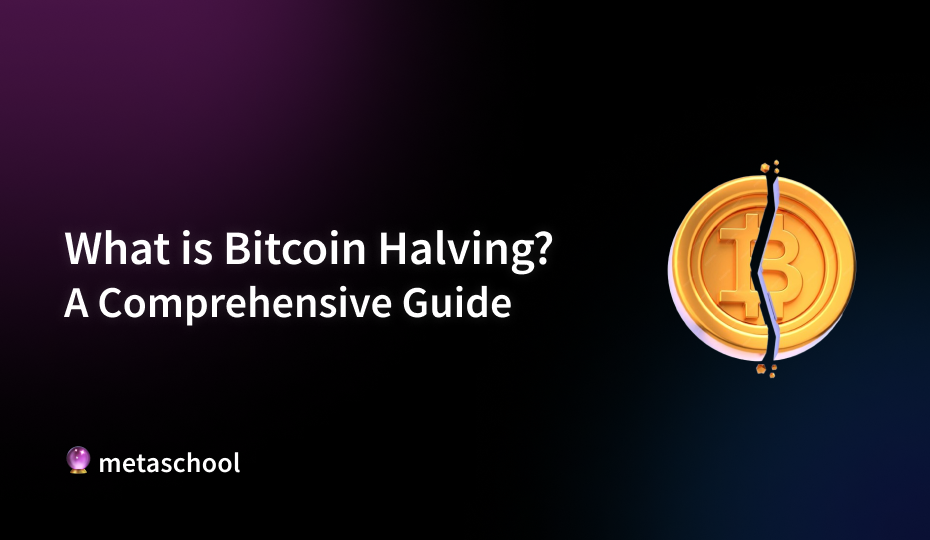Table of Contents
What is Bitcoin Halving?
Bitcoin Halving is a significant event programmed into the Bitcoin protocol and takes place every 210,000 blocks, which translates to approximately every four years. When a halving event occurs, the reward that miners receive for successfully adding a new block to the Bitcoin blockchain is cut in half. This reduction decreases the number of new Bitcoins generated through mining and entering the market.
The concept of halving was introduced by Bitcoin’s creator, Satoshi Nakamoto, as a mechanism to control Bitcoin’s supply and increase its scarcity over time. By limiting the amount of new Bitcoins that can be mined, halving helps to create an environment where demand can potentially outpace supply, which may positively affect Bitcoin’s price.
How does it work?
Bitcoin has a fixed supply limit, meaning that only a certain number of Bitcoins can ever exist. This limit is set at 21 million Bitcoins. The process of Bitcoin Halving gradually reduces the number of new Bitcoins that are created and introduced into circulation through mining.
Here’s how it works:
- Fixed Supply Limit: Bitcoin’s code dictates that there will only ever be 21 million Bitcoins in existence. No more Bitcoins can be created after this limit is reached.
- Halving Process: Every time a new block is added to the Bitcoin blockchain, miners are rewarded with a certain number of new Bitcoins. However, approximately every four years, the reward for mining a new block is cut in half. This event is called Bitcoin Halving.
- Slowing Down Bitcoin Creation: When Bitcoin first started, the reward for mining a block was 50 Bitcoins. After the first halving, it became 25 Bitcoins, then 12.5 Bitcoins after the second halving, and so on. With each halving, the number of new Bitcoins created every 10 minutes (the average time it takes to mine a block) is reduced, making the creation of new Bitcoins slower and slower over time.
- Approaching the Limit: As the rewards continue to halve, the number of new Bitcoins being created becomes smaller and smaller. Over time, this process will result in fewer and fewer Bitcoins being added to the total supply. Eventually, the rewards will become so small that no more new Bitcoins will be created.
- Reaching 21 Million: Based on the halving schedule, it’s estimated that the final Bitcoin will be mined around the year 2140. At that point, the total number of Bitcoins in existence will reach the 21 million limit, and no more Bitcoins will be created. Miners will no longer receive new Bitcoins as a reward for their work. Instead, their income will come solely from transaction fees paid by users who want their transactions included in the blockchain.
Note: To fully understand the process you must first have some knowledge of how Bitcoin works.
Effects of Bitcoin Halving
Bitcoin Halving is a significant event that impacts various aspects of the Bitcoin ecosystem, from inflation and market demand to mining and consumer behavior. Here’s how the halving influences these areas:
Inflation Control
One of the primary reasons for Bitcoin Halving is to address inflation concerns. Inflation typically refers to the decrease in purchasing power of a currency over time, which central banks often attempt to control by setting an inflation rate target, usually around 2%. However, Bitcoin operates differently. The halving reduces the rate at which new Bitcoins are introduced into the market, thereby limiting the supply and helping to maintain the cryptocurrency’s scarcity. This scarcity is intended to protect Bitcoin’s value from inflationary pressures.
Market Demand
Another critical effect of Bitcoin Halving is its influence on market demand. As the supply of new Bitcoins is reduced by halving, demand typically increases. Historically, this increased demand has driven up the price of Bitcoin, making it an attractive investment opportunity for both new and existing investors. After each halving event, Bitcoin’s price has generally seen a significant rise, reflecting the increased demand amidst reduced supply. For investors and speculators, this trend is seen as a positive outcome, potentially leading to higher returns on investment.
Investment Potential
Although Bitcoin was originally designed as a decentralized payment method, it has evolved into a popular investment asset. The predictable reduction in new Bitcoin supply due to halving events has contributed to this shift. For investors, each halving presents an opportunity to capitalize on the potential price increase resulting from decreased supply. However, this also places Bitcoin in the realm of speculation, as investors are essentially betting on the cryptocurrency’s value increasing over time. While this can lead to significant gains, it also comes with inherent risks, particularly if market conditions do not follow historical patterns.
Mining Profitability
Miners, who play a crucial role in securing the Bitcoin network by validating transactions, are directly impacted by Bitcoin Halving. Each halving event reduces the reward they receive for mining a block by 50%, making mining less profitable if Bitcoin’s price does not increase proportionately. For large-scale mining operations, the decrease in rewards can be mitigated by scaling up operations, as seen with firms like Marathon Digital Holdings, which expanded its mining capacity in anticipation of the 2024 halving.
However, for smaller miners or those participating in mining pools, the reduction in rewards poses a significant challenge. Even if Bitcoin’s price increases, the rewards are still halved, which means that smaller miners may struggle to cover their operational costs and remain competitive in the industry.
Impact on Consumers
For everyday Bitcoin users, the effects of halving are mostly felt through price fluctuations. Consumers who hold Bitcoin or use it for purchases will notice that the value of their Bitcoin can vary significantly after a halving event. Those who use Bitcoin for remittances or other transactions will be affected in much the same way; the value of their funds will depend on Bitcoin’s market price post-halving. While the halving doesn’t directly change how consumers use Bitcoin, it does influence the value of their holdings, which can impact their purchasing power and financial decisions.
Conclusion
Bitcoin Halving is a pivotal event in the cryptocurrency’s lifecycle and serves to limit the total supply of Bitcoin to 21 million coins, increasing its scarcity over time. It plays a crucial role in controlling Bitcoin’s inflation rate, as it slows down the creation of new Bitcoins, which can lead to a rise in the cryptocurrency’s market value if demand remains constant or increases.
For investors, this event often represents an opportunity to benefit from potential price increases due to reduced supply. However, for miners, the halving event can pose significant challenges, as their profitability is directly impacted by the reduced rewards. Consumers who use Bitcoin for transactions or remittances may also feel the effects through price fluctuations, which can influence the value of their holdings. Whether it’s a good thing or not depends on one’s perspective—investors may benefit from potential price increases, while miners and consumers face a more complex set of outcomes. Understanding these dynamics is essential for anyone looking to navigate the ever-evolving landscape of Bitcoin and the broader cryptocurrency market.
FAQs
When was the first Bitcoin halving?
The first bitcoin halving occurred on 28th November 2012. The next halving was in July 2016, followed by a halving in May 2020. The most recent halving was on 19th April 2024.
How long will the halving event continue?
Bitcoin halvings will continue to occur roughly every four years until the block reward eventually reaches zero. At that point, miners will earn rewards solely from transaction fees included in each block.
Why does Bitcoin halving increase the price?
Bitcoin halving typically leads to an increase in the cryptocurrency’s price due to the economic principle of supply and demand. When a halving occurs, the reward for mining new Bitcoin blocks is cut in half, which reduces the rate at which new Bitcoins are introduced into the market. This reduction in supply growth creates a scarcity effect, assuming demand remains steady or increases.
As fewer new Bitcoins become available, their perceived value tends to rise, driving up the price. This scarcity effect is central to Bitcoin’s design, as it ensures that the total supply is capped at 21 million Bitcoins. Decreased supply, combined with increasing or stable demand, usually leads to a rise in price.

